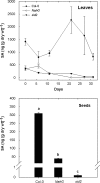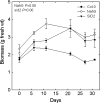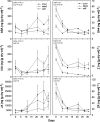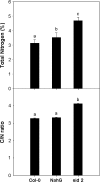Salicylic acid deficiency in NahG transgenic lines and sid2 mutants increases seed yield in the annual plant Arabidopsis thaliana
- PMID: 19188277
- PMCID: PMC2657544
- DOI: 10.1093/jxb/ern363
Salicylic acid deficiency in NahG transgenic lines and sid2 mutants increases seed yield in the annual plant Arabidopsis thaliana
Abstract
Salicylic acid-deficient NahG transgenic lines and sid2 mutants were used to evaluate the role of this compound in the development of the short-lived, annual plant Arabidopsis thaliana, with a particular focus on the interplay between salicylic acid and other phytohormones. Low salicylic acid levels led to increased growth, as well as to smaller abscisic acid levels and reduced damage to PSII (as indicated by F(v)/F(m) ratios) during the reproductive stages in rosette leaves of NahG transgenic lines and sid2 mutants, compared with wild-type plants. Furthermore, salicylic acid deficiency highly influenced seed yield and composition. Seed production increased by 4.4-fold and 3.5-fold in NahG transgenic lines and sid2 mutants, respectively, compared to the wild type. Salicylic acid deficiency also improved seed composition in terms of antioxidant vitamin concentrations, seeds of salicylic acid-deficient plants showing higher levels of alpha- and gamma-tocopherol (vitamin E) and beta-carotene (pro-vitamin A) than seeds of wild-type plants. Seeds of salicylic acid-deficient plants also showed higher nitrogen concentrations than seeds of wild-type plants. It is concluded that (i) the sid2 gene, which encodes for isochorismate synthase, plays a central role in salicylic acid biosynthesis during plant development in A. thaliana, (ii) salicylic acid plays a role in the regulation of growth, senescence, and seed production, (iii) there is a cross-talk between salicylic acid and other phytohormones during plant development, and (iv) the concentrations of antioxidant vitamins in seeds may be influenced by the endogenous levels of salicylic acid in plants.
Figures







References
-
- Abreu ME, Munné-Bosch S. Salicylic acid may be involved in the regulation of drought-induced leaf senescence in perennials: a case study in field-grown Salvia officinalis L. plants. Environmental and Experimental Botany. 2008;64:105–112.
-
- Achard P, Herr A, Baulcombe DC, Harberd NP. Modulation of floral development by a gibberellin-regulated microRNA. Development. 2004;131:3357–3365. - PubMed
-
- Buchanan-Wollaston V, Page T, Harrison E, et al. Comparative transcriptome analysis reveals significant differences in gene expression and signalling pathways between developmental and dark/starvation-induced senescence in Arabidopsis. The Plant Journal. 2005;42:567–585. - PubMed
-
- Chiwocha SDS, Abrams SR, Ambrose SJ, Cutler AJ, Loewen M, Ross ARS, Kermode AR. A method for profiling classes of plant hormones and their metabolites using liquid chromatography–electrospray ionization tandem mass spectrometry: an analysis of hormone regulation of thermodormancy of lettuce (Lactuca sativa L.) seeds. The Plant Journal. 2003;35:405–417. - PubMed
Publication types
MeSH terms
Substances
LinkOut - more resources
Full Text Sources
Molecular Biology Databases

